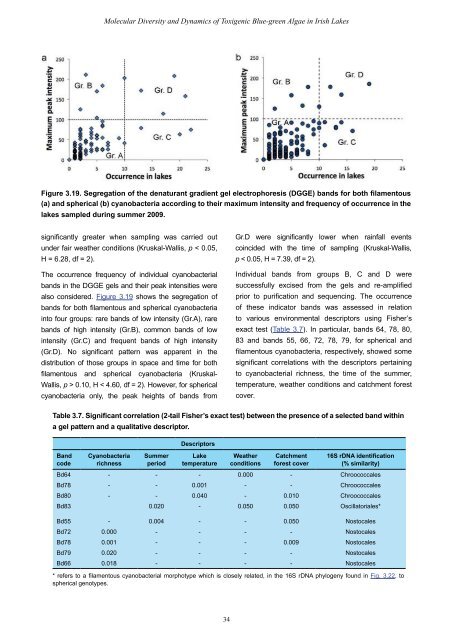STRIVE - Environmental Protection Agency
STRIVE - Environmental Protection Agency
STRIVE - Environmental Protection Agency
You also want an ePaper? Increase the reach of your titles
YUMPU automatically turns print PDFs into web optimized ePapers that Google loves.
Molecular Diversity and Dynamics of Toxigenic Blue-green Algae in Irish Lakes<br />
Figure 3.19. Segregation of the denaturant gradient gel electrophoresis (DGGE) bands for both filamentous<br />
(a) and spherical (b) cyanobacteria according to their maximum intensity and frequency of occurrence in the<br />
lakes sampled during summer 2009.<br />
significantly greater when sampling was carried out<br />
under fair weather conditions (Kruskal-Wallis, p < 0.05,<br />
H = 6.28, df = 2).<br />
The occurrence frequency of individual cyanobacterial<br />
bands in the DGGE gels and their peak intensities were<br />
also considered. Figure 3.19 shows the segregation of<br />
bands for both filamentous and spherical cyanobacteria<br />
into four groups: rare bands of low intensity (Gr.A), rare<br />
bands of high intensity (Gr.B), common bands of low<br />
intensity (Gr.C) and frequent bands of high intensity<br />
(Gr.D). No significant pattern was apparent in the<br />
distribution of those groups in space and time for both<br />
filamentous and spherical cyanobacteria (Kruskal-<br />
Wallis, p > 0.10, H < 4.60, df = 2). However, for spherical<br />
cyanobacteria only, the peak heights of bands from<br />
34<br />
Gr.D were significantly lower when rainfall events<br />
coincided with the time of sampling (Kruskal-Wallis,<br />
p < 0.05, H = 7.39, df = 2).<br />
Individual bands from groups B, C and D were<br />
successfully excised from the gels and re-amplified<br />
prior to purification and sequencing. The occurrence<br />
of these indicator bands was assessed in relation<br />
to various environmental descriptors using Fisher’s<br />
exact test (Table 3.7). In particular, bands 64, 78, 80,<br />
83 and bands 55, 66, 72, 78, 79, for spherical and<br />
filamentous cyanobacteria, respectively, showed some<br />
significant correlations with the descriptors pertaining<br />
to cyanobacterial richness, the time of the summer,<br />
temperature, weather conditions and catchment forest<br />
cover.<br />
Table 3.7. Significant correlation (2-tail Fisher’s exact test) between the presence of a selected band within<br />
a gel pattern and a qualitative descriptor.<br />
Band<br />
code<br />
Cyanobacteria<br />
richness<br />
Summer<br />
period<br />
Descriptors<br />
Lake<br />
temperature<br />
Weather<br />
conditions<br />
Catchment<br />
forest cover<br />
16S rDNA identification<br />
(% similarity)<br />
Bd64 - - - 0.000 - Chroococcales<br />
Bd78 - - 0.001 - - Chroococcales<br />
Bd80 - - 0.040 - 0.010 Chroococcales<br />
Bd83 0.020 - 0.050 0.050 Oscillatoriales*<br />
Bd55 - 0.004 - - 0.050 Nostocales<br />
Bd72 0.000 - - - - Nostocales<br />
Bd78 0.001 - - - 0.009 Nostocales<br />
Bd79 0.020 - - - - Nostocales<br />
Bd66 0.018 - - - - Nostocales<br />
* refers to a filamentous cyanobacterial morphotype which is closely related, in the 16S rDNA phylogeny found in Fig. 3.22, to<br />
spherical genotypes.

















